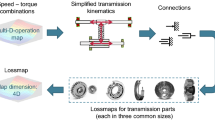Abstract
There is rarely a general or standard method to calculate the overall efficiency of a complete vehicle gearbox. This paper aims to develop such method which can possibly be applied to different types of transmissions in a flexible way and provide a platform to compare several different products from different OEMs or suppliers in parallel.
A number of standards and publications concerning the calculation of power losses specifically for one transmission component such as gears, roller bearings or specific phenomenon like oil churning are available in the literature. Different models from these sources are compared, selected and combined to obtain the resulting efficiency map of a complete gearbox system.
This paper presents the calculation of such a combined efficiency map of a transmission for an electric vehicle through either the standard models (ISO14179) for industry transmissions or this new joint overall model. The comparisons of available experimental data and calculations show that the result of the joint overall model has a better proximity to the test results. Nevertheless, the uncertainties in the input parameters of the model strongly affect the calculated power loss and the resulting efficiency of the gearbox. Parameter studies are conducted to determine the most influential parameters in the joint overall model. Several selected parameters are identified through experimental overall efficiency maps by classic parameter identification method and algorithm. On the one hand, a much better proximity is achieved. On the other hand, the identified parameters indicate the optimization potential of the component losses for benchmarking of transmissions.
Zusammenfassung
In der Literatur ist eine generelle oder standardisierte Methode kaum zu finden, den Gesamtwirkungsgrad des Getriebes im Fahrzeug zu berechnen. Ziel diese Papers ist es solche Methode zu entwickeln, um sie an verschiedenen Getriebe flexibel anwenden zu können und eine Plattform liefern zu können, womit verschiedenen Getriebe von Lieferanten parallel verglichen werden können.
Mehrere Normen und Veröffentlichungen über die Berechnung des Energieverlusts von einzelnen Komponente wie Zahnräder, Lager oder spezielle Phänomenen (z. B. Planschverluste) sind in der Literatur schon verfügbar. Verschiedenen Modelle aus diesen Quellen werden hier verglichen, ausgewählt und kombiniert, um das Kennfeld des Gesamtwirkungsgrads eines kompletten Fahrzeuggetriebes zu erzeugen.
In dieser Arbeit wird der Gesamtwirkungsgrads eines Getriebes in einem Elektrofahrzeug zum einen durch das Model aus der Norm (ISO14179) und zum anderen durch das neue kombinierte Model berechnet. Nach dem Vergleich zwischen Messwerten und der Berechnungsergebnissen zeigt das kombinierte Model eine bessere Anpassung an die Messdaten. Dennoch beeinflusst die Parameterunsicherheit des kombinierten Models stark die Berechnungsergebnisse. Eine Parameterstudie wurde durchgeführt um einflussreiche Parameter zu bestimmen. Die ausgewählten Parameter sind durch einen klassischen Algorithmus identifiziert mit Hilfe des durch Experiment bestimmten Gesamtwirkungsgrades. Einerseits wird noch eine bessere Anpassung an die Messdaten erreicht. Anderseits deuten die identifizierten Parameter auf potenzielle Optimierungsmöglichkeiten der Komponenten in Getriebe in Bezug auf Energieverluste hin.







Similar content being viewed by others
References
Ernst CS, Eckstein L, Olschewski I (2012) CO2-Reduzierungspotenziale bei Pkw bis 2020. Abschlussbericht Dezember
Sedlmair M, Geiger J, Stemplinger J-P, Stahl K (2015) Efficiency potential of a manual transmission: simulation of optimization measures in gears and lubricants. 15th Intern. VDI-Congress dqDrivetrain for Vehicles.
ISO, B(2001) TR14179-2-2001 Gear-thermal capacity Part2: Thermal load-carrying capacity.
Fernandes CMCG et al (2015) Gearbox power loss. Part III: application to a parallel axis and a planetary gearbox. Tribol Int 88:317–326
Rosander P et al (2008) Entwicklung eines Wirkungsgrad-modells für Schaltgetriebe. Atz-automobiltechnische Zeitschrift 110(4):346–357
Niemann G, Winter H (2003) Maschinenelemente, 2nd edn. vol. 2. Springer, Berlin Heidelberg
Anderson NE, Loewenthal SH (1982) Design of spur gears for improved efficiency. J Mech Des 104(4):767–774
Anderson NE, Loewenthal SH (1980) Spur-gear-system efficiency at part and full load. National Aeronautics And Space Administration Cleveland Ohio Lewis Research Center, Cleveland
Petry-Johnson TT et al (2008) An experimental investigation of spur gear efficiency. J Mech Des 130(6):062601
Mauz, Wolfgang(2008) Hydraulische Verluste von Stirnradgetrieben bei Umfangsgeschwindigkeiten bis 60m/s. Dissertation, Universität Stuttgart.
Changenet C, Velex P (2007) A model for the prediction of churning losses in geared transmissions preliminary results. J Mech Des 129(1):128–133
Seetharaman S, Kahraman A (2010) A windage power loss model for spur gear pairs. Tribol Trans 53(4):473–484
SKF GmbH (2004) SKF-Hauptkatalog: das Wälzlager-Handbuch für Studenten. Katalog 5000 G. SKF GmbH, Schweinfurt
Schaeffler Gruppe (2006) INA/FAG Wälzlagerkatalog
Simrit (1976) Radialwellendichtringe, Katalog Nr. 100
ISO, B. (2001) TR14179-2-2001 Gear-thermal capacity Part2: Thermal load-carrying capacity.
Drozdov YN, Gavrikov YA (1968) Friction and scoring under the conditions of simultaneous rolling and sliding of bodies. Wear 11(4):291–302
O’donoghue JP, Cameron A (1966) Friction and temperature in rolling sliding contacts. ASLE Trans 9(2):186–194
Kelley BW, Lemanski AJ (1967) Paper 11: lubrication of involute gearing. Proc Inst Mech Eng 182(1):173–184
Xu, Hai(2005) Development of a generalized mechanical efficiency prediction methodology for gear pairs. Dissertation, The Ohio State University.
Ohlendorf, H (1958) Verlustleistung und Erwärmung von Stirnrädern, Dissertation, TU München
Fernandes CM, Marques PM, Martins RC, Seabra JH (2015) Gearbox power loss. Part II: friction losses in gears. Tribol Int 88:309–316
Mauz, Wolfgang(1988) Hydraulische Verluste von Stirnradgetrieben bei umfangsgeschwindigkeiten bis 60m/s. Dissertation, Universität Stuttgart.
Boness RJ (1989) Churning losses of discs and gears running partially submerged in oil. Proc ASME Int Power Trans Gearing Conf 1:255–359
Changenet C, Velex P (2007) A model for the prediction of churning losses in geared transmissions preliminary results. J Mech Des 129(1):128–133
Schaeffler Gruppe (2008) INA/FAG Wälzlagerkatalog
Conn AR, Gould NIM, Toint PL (2000) Trust region methods. Society for Industrial and Applied Mathematics, Philadelphia
Author information
Authors and Affiliations
Corresponding author
Rights and permissions
About this article
Cite this article
Shen, Y., Rinderknecht, S. & Hoppert, M. General modelling method of power losses in transmission with parameter identification. Forsch Ingenieurwes 81, 117–123 (2017). https://doi.org/10.1007/s10010-017-0241-1
Received:
Published:
Issue Date:
DOI: https://doi.org/10.1007/s10010-017-0241-1




